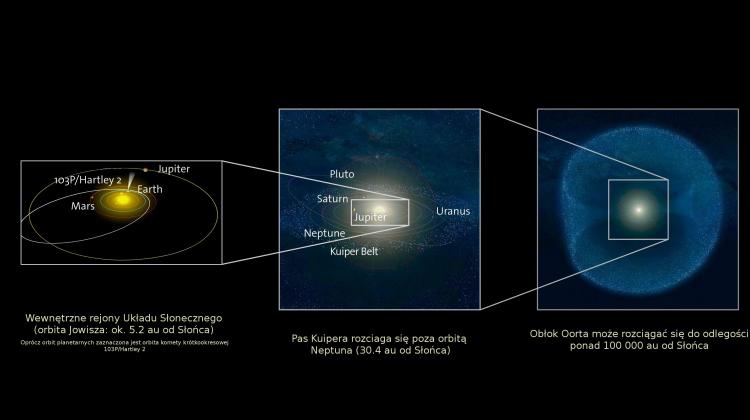Herschel Space Telescope studied comets and water they contained

Summary of research of Polish scientists associated with the Herschel mission, in particular studies of comets has been presented in the release of the Space Research Centre of the Polish Academy of Sciences. Herschel Space Telescope studied cool objects across the Universe, including comets.
During the four years of its mission, Herschel Space Telescope studied cool objects across the Universe. This category includes comets, which the telescope observed in the microwave range.
One of the most important results is the evaluation of the ratio of hydrogen and its heavier isotope - deuterium. The ratio of deuterium to hydrogen has been examined for the two comets: 103P/Hartley 2 and C/2009 P1 Garrard. The results were quite surprising, because in the first case, the ratio was similar to that measured in Earth\'s oceans, and the second case higher.
Why this difference? According to Dr. Sławomir Szutowicz of Solar System Dynamics and Planetology Team at the Space Research Centre PAS, co-author of papers on the two comets - the ratio of deuterium to hydrogen is an indication of where the object was formed at the beginning of the solar system existence. In the original nebula from which the Sun formed, the synthesis reaction of water molecules occurred involving both hydrogen and deuterium. At low temperatures, the the accumulation of deuterium in wateris more favoured, so the farther away from the Sun the object formed, the more of the isotope its water should contain.
The first comet 103P/Hartley 2, belongs to the short-period comets, and probably formed in the outer parts of the solar system beyond the orbit of Uranus. The comet C/2009 P1 Garrard is a long-period comet and scientists speculate that it comes from a hypothetical Oort cloud, which is located much further.
The water on Earth has not necessarily been on the planet since its formation. Some could be brought at different stages, and scientists do argue as to how this process followed and from which areas of the solar system water was supplied. According to the prevailing theory, at most 10 percent of the water has its source in comets, in which ice is the main part of the nuclei. Herschel measurements suggest that comets’ contribution could be greater.
"Our measurements showed that in the Hartley 2 comet water, there are 6200 hydrogen atoms per one deuterium atom, just like in water on Earth. Hence the conclusion that not only collisions with asteroids, but also comets should be seriously taken into account in the discussion about the objects that brought water to Earth in the past" - said Szutowicz.
Researchers at the Space Research Centre PAS also participated in the study of other objects using the Herschel observatory. They co-authored several publications on the observation atmospheres of large planets, moons of Saturn and Mars, and cometary atmospheres. Polish research was funded by the Ministry of Science and Higher Education grant.
In late April, the European Space Agency (ESA) announced the exhaustion of liquid helium, cooling agent for the Herschel Space Observatory detectors. This completes the observations carried out with this instrument since 2009.
PAP - Science and Scholarship in Poland
cza/ krf/ mrt/
tr. RL
Przed dodaniem komentarza prosimy o zapoznanie z Regulaminem forum serwisu Nauka w Polsce.


















